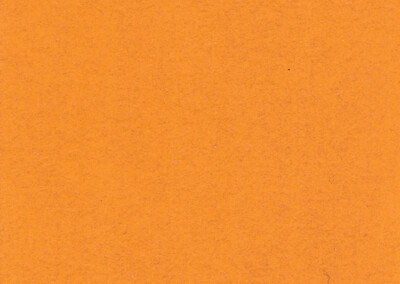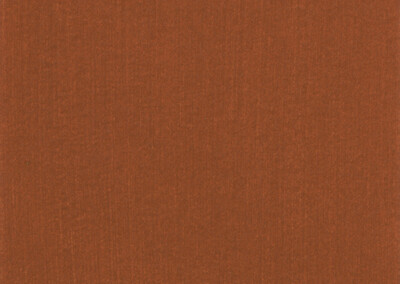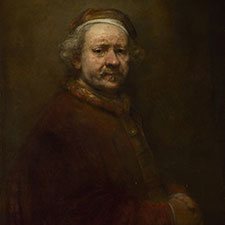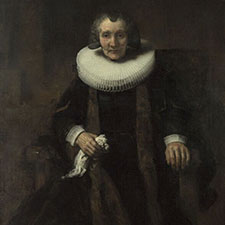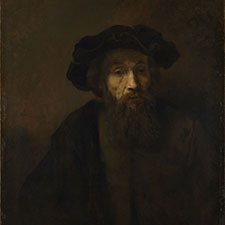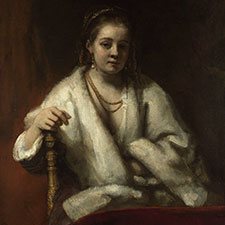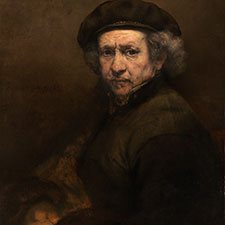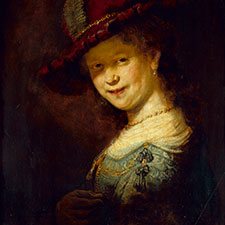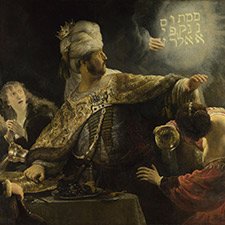Rembrandt, The Rape of Ganymede
1635Rembrandt, The Rape of Ganymede
1635Paintings sorted by Historical period | Painter | Subject matter | Pigments used
Overview
The painting is also known as Rembrandt, The Abduction of Ganymede
Medium: Oil
Support: Oak panel
Size: 177 x 129 cm
Art period: Baroque
Staatliche Kunstsammlungen Dresden – Gemäldegalerie Alte Meister (State Art Gallery Dresden)
Gallery Nr 1558
Image credit: The Rembrandt Database, 2005, (record number 15605); Rembrandt, The Rape of Ganymede
Characterization of this painting by the scientists of the Rembrandt Research Foundation (1):
“An authentic work, for the most part poorly preserved and much overpainted, reliably signed and dated 1635.”
(1) J. Bruyn, B. Haak, S. H. Levie, P. J. J. Van Thiel, E. Van De Wetering, The rape of Ganymede, in A Corpus of Rembrandt Paintings, Stichting Foundation Rembrandt Research Project Volume 3, 1989, pp 161-167.
The Story in the Greek Mythology
Ganymede, a son of King Tros of Dardania and the most handsome of all mortals, was tending sheep when he was seized by an eagle sent by Zeus (or by Zeus himself transformed into an eagle) and brought to the Olymp to become the cupbearer of gods and a lover of Zeus. He was granted eternal youth and immortality and received his place in heaven as the constellation Aquarius.
One of the sources of this myth is Homer’s Illiad (1):
“The sacred Tros, of whom the Trojan name. Three sons renown’d adorn’d his nuptial bed, Ilus, Assaracus, and Ganymed: The matchless Ganymed, divinely fair, Whom heaven, enamour’d, snatch’d to upper air, To bear the cup of Jove (ethereal guest, The grace and glory of the ambrosial feast).”
The Roman poet Ovid gives the following account of the same story in his Metamorphoses (2):
“The king of the gods once burned with love for PhrygianGanymede,
and to win him Jupiter chose to be something other than he was.
Yet he did not deign to transform himself into any other bird,
than that eagle, that could carry his lightning bolts.
Straightaway, he beat the air with deceitful wings, and stole the Trojan boy,
who still handles the mixing cups, and against Juno’s will pours out Jove’s nectar.”
Still another version of the Ganymede myth can be found in Virgil’s Aeneid (3):
“There Ganymede is wrought with living art,
Chasing thro’ Ida’s groves the trembling hart:
Breathless he seems, yet eager to pursue;
When from aloft descends, in open view,
The bird of Jove, and, sousing on his prey,
With crooked talons bears the boy away.
In vain, with lifted hands and gazing eyes,
His guards behold him soaring thro’ the skies,
And dogs pursue his flight with imitated cries.”

Roman Relief, Rape of Ganymede, 1st century AD
References
(1) Homer, Illiad, Book XX. p. 603. Translation by Alexander Pope, digitalized by Project Gutenberg (2006).
(2) Ovid, Metamorphoses, book X. 143-219, translated by A. S. Kline.
(3) Virgil, Aeneid, book V. Translation by J. Dryden.
(4) Ganymedes, Theoi Greek Mythology website.
Video: 'The Story of Zeus and Ganymede' by Jena Bruno
Related Paintings

Antonio Allegri called Correggio, Abduction of Ganymede, 1520-40
a

Peter Paul Rubens, The Rape of Ganymede, 1611
a

Eustache Le Sueur, Abduction of Ganymede, ca 1650
Pigments
Pigment Analysis
This pigment analysis is based on the analysis of Heike Stege at the Doerner Institute in Munich in 2003 (1). This painting was also analyzed in 1975 by Hermann Kühn in the same institute (2).
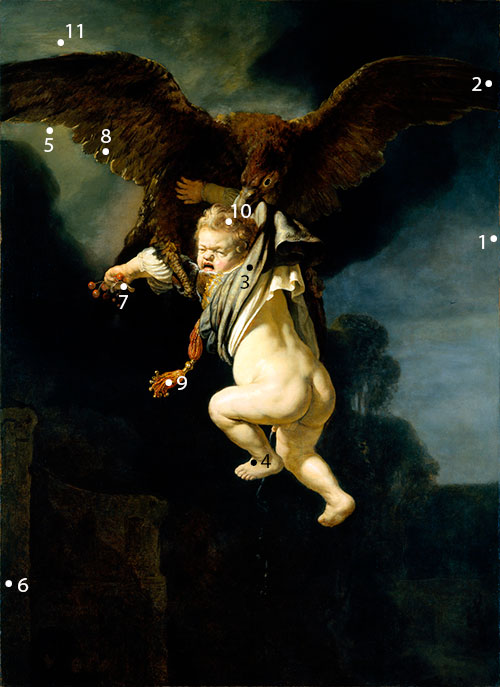
1 Blue-gray background: chalk, gypsum, bone black, yellow ochre, few particles of vermilion and lead white

2 Brown wing: brown ochre, bone black, lead white, chalk, and gypsum
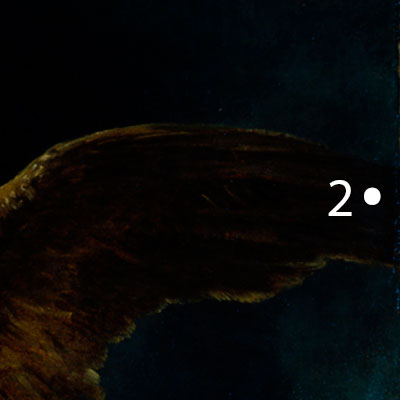
3 Light blue shirt of Ganymede: smalt, red ochre, lead white and gypsum
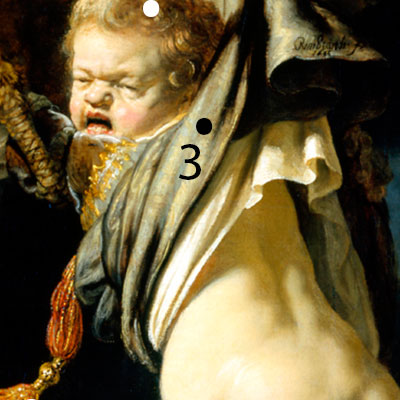
4 Flesh colour from the foot of Ganymede: vermilion, brown ochre, carbon-based black pigment, lead white and chalk

5 Bright background: orange ochre, charcoal black or bone black, chalk, lead white and gypsum (no green pigment was found)
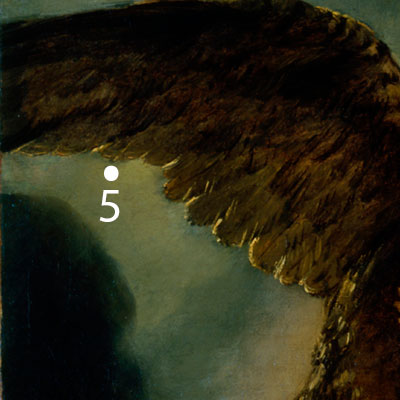
6 Dark green background consisting of several layers:
1 orange layer: orange ochre and isolated particles of vermilion
2 another orange layer: orange ochre and bone black
3 white layer: lead white, yellow ochre, charcoal black, and chalk
4 dark brown layer: bone black, small amounts of vermilion, lead white and gypsum. Possibly unidentified organic colorant
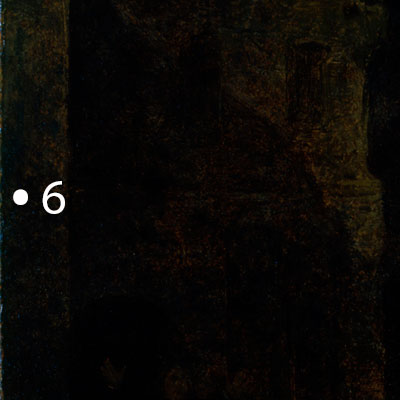
7 red-brown shadow in the hand of Ganymede consisting of several layers:
1 white layer: lead white, yellow ochre and bone black
2 dark brown layer: brown ochre, bone black, isolated particles of vermilion, chalk and small amounts of lead white
3 brown layer: bone black, yellow ochre, small amounts of vermilion, smalt, chalk, and lead white
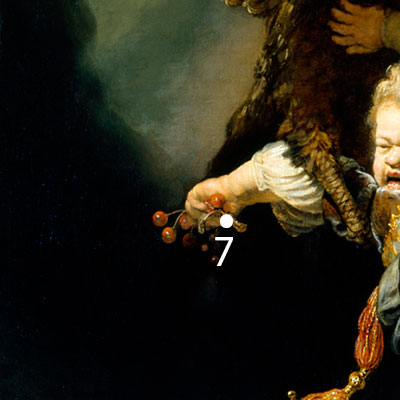
8 Yellow-brown wing of the eagle consisting of several layers:
1 rest of a white layer: lead white, small amounts of bone black and small amounts of ochre
2 gray layer: charcoal black, yellow ochre, isolated particles of vermilion, lead white and chalk
3 thin brown layer: organic colorant (contains chlorine)
4 white layer: lead white, charcoal black, possibly also small amounts of bone black, very small amounts of orange ochre
5 brown layer: yellow ochre, bone black, chalk and very small amounts of vermillion

9 Red tassel consisting of several layers:
1 yellow layer: yellow ochre
2 orange-red layer: orange ochre, vermilion, chalk, and gypsum. Also brown organic colorant or brown ochre
3 light brown layer: brown ochre, bone black, lead-tin-yellow, ochre and very small amounts of lead white
4 thin yellow layer (not continuous): lead-tin-yellow and chalk
5 thin white layer (underpainting): lead white, chalk, bone black and small amounts of ochre
6 brown layer: bone black, charcoal black, lead-tin-yellow, ochre, smalt, isolated particles of a red lake, chalk and lead white
7 darker brown layer: charcoal black, bone black, very small amounts of vermilion, ochre, chalk, lead white and gypsum
8 white layer: lead white and very small amounts of ochre
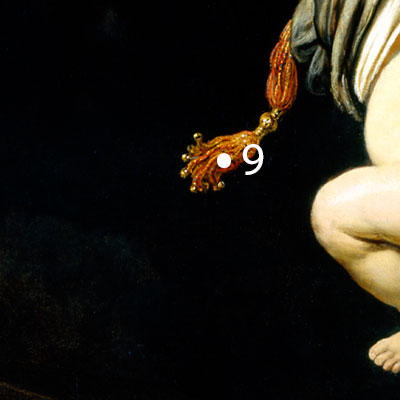
10 Brown hair of Ganymede consisting of several layers:
1 transparent brown layer: organic matter.
2 white layer (in the middle): organic matter.
3 white layer: lead white, chalk, small amounts of ochre, and small amounts of charcoal black.
4 thin brownish layer: organic matter.
5 thin orange layer: orange ochre.
6 white layer: lead white, chalk, small amounts of red ochre and isolated particles of vermilion
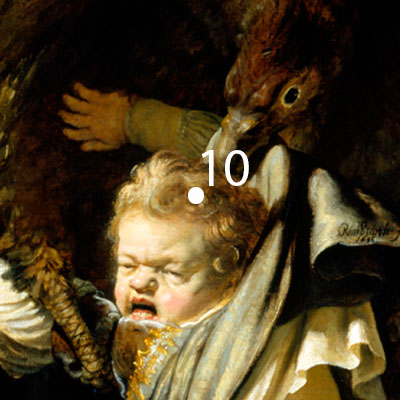
11 Yellow lightning consisting of several layers:
1 gray layer: charcoal black, bone black, yellow ochre, lead white, chalk and gypsum
2 transparent dark brown layer: organic layer, charcoal black and small amounts of gypsum
3 yellow to brownish layer: yellow ochre and vermilion
4 very thin brown layer: yellow ochre and chrome yellow (!) (modern pigment applied later by a conservator)
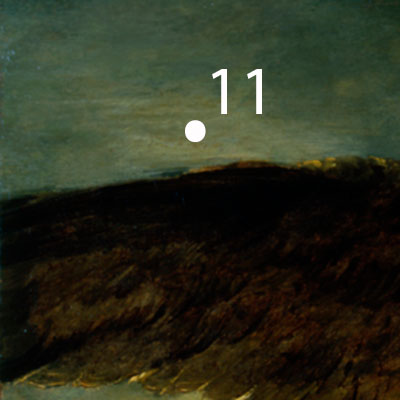
References
(1) The Rembrandt Database, various research methods: examination report, 19 November 2003, (record number 16786); Rembrandt The rape of Ganymede, dated 1635, Staatliche Kunstsammlungen Dresden – Gemäldegalerie Alte Meister, Dresden, inv./cat. no. 1558.
(2) Kühn, Hermann. ‘Untersuchungen zu den Pigmenten und Malgründen Rembrandts, durchgeführt an den Gemälden der Staatlichen Kunstsammlungen Dresden’, Maltechnik/Restauro, issue 4 (1977): 223-233.
Pigments Used in This Painting
Resources
See the collection of online and offline resources such as books, articles, videos, and websites on Rembrandt in the section ‘Resources on Painters‘
PowerPoint Presentations
Painter in Context: Rembrandt
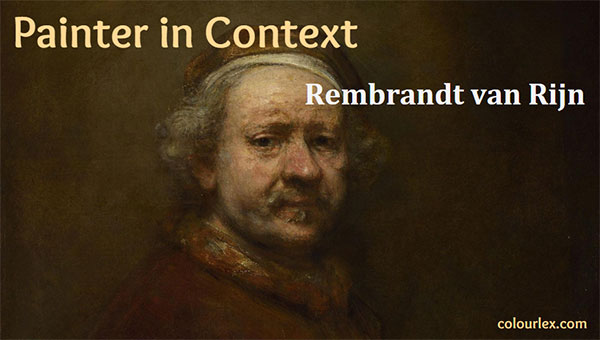
A richly illustrated presentation on the painting technique and pigments employed by Hieronymus Bosch specially crafted for Art Education. (Number of Slides = 20)
- Each presentation starts with the basic resources on the painter such as his biography, main catalogs of his paintings, and a bibliography.
- Next, you find slides describing the painting technique of the artist and the pigments he usually employed in his work.
- The majority of the slides show examples of paintings containing the specific pigments.



The majority of the slides show important examples of paintings where Rembrandt employed specific pigments. The slides are organized according to the color of the pigments.
Publications and Websites
Publications
(1) Margarita Russell, The Iconography of Rembrandt’s “Rape of Ganymede”, Simiolus: Netherlands Quarterly for the History of Art, Vol. 9, No. 1 (1977), pp. 5-18, Article DOI: 10.2307/3780422
(2) Kühn, Hermann. ‘Untersuchungen zu den Pigmenten und Malgründen Rembrandts, durchgeführt an den Gemälden der Staatlichen Kunstsammlungen Dresden’, Maltechnik/Restauro, issue 4 (1977): 223-33
(3) J. Bruyn, B. Haak, S. H. Levie, P. J. J. Van Thiel, E. Van De Wetering, The rape of Ganymede, in A Corpus of Rembrandt Paintings, Stichting Foundation Rembrandt Research Project Volume 3, 1989, pp 161-167.
A Corpus of Rembrandt Paintings, Volumes I – VI, by the scientists of The Rembrandt Research Project are available on the website of The Rembrandt Database in pdf-Format.
Websites
The Rembrandt Database, normal light studies: color photo (print), overall (front), 2005, (record number 15605); Rembrandt, The Rape of Ganymede, dated 1635, Staatliche Kunstsammlungen Dresden – Gemäldegalerie Alte Meister, Dresden, inv./cat. no. 1558



